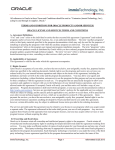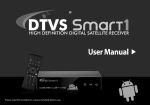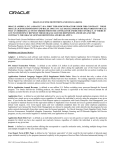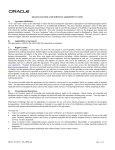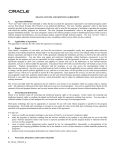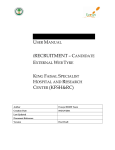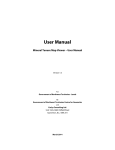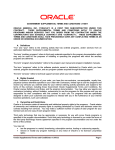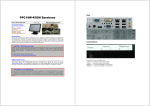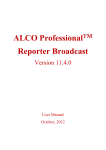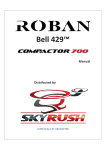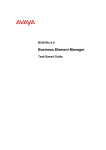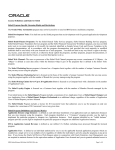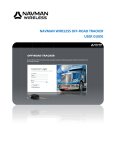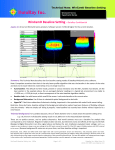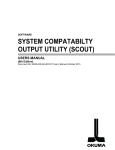Download Oracle License Definitions and Rules
Transcript
ORACLE
O
LIC
CENSE DEFINITIONS AN
ND RULES (v0081011r1)
OR
RACLE AMER
RICA, INC. (“
“ORACLE”) IS A FIRST TIER
T
SUBCO
ONTRACTOR
R UNDER TH
HIS CONTRAC
CT. THESE
OR
RACLE LICEN
NSE DEFINIT
TIONS AND RULES
R
APPL
LY TO ALL ORACLE
O
PRO
OGRAMS DE
ELIVERED BY
B ORACLE
TH
HAT AN ORD
DERING ACT
TIVITY ORD
DERS FROM
M THE CONTRACTOR UNDER
U
THE
E CONTRAC
CT. THESE
LIC
CENSE DEFIN
NITIONS AN
ND RULES AR
RE CONSIDE
ERED PART OF
O THE SCH
HEDULE OF SUPPLIES/SE
S
ERVICES.
Forr these Oracle License Defin
nitions and Ruules, “you/youur” shall havee the same meeaning as “orddering activity”. The term
“orddering activityy” refers to a th
hird party that is eligible (as identified in Appendices
A
A, B and C of GSA ADM 48000.2G and any
subsequent revisioon) to place orders
o
off this GSA Schedulle contract. Inn addition, if you have opteed into GSA’ss Cooperative
Purrchasing Prograam, the term “ordering activvity” includes state and locaal governmentt entities authoorized throughh Cooperative
Purrchasing (GSAM
M Subpart 538
8.70) to place orders
o
off this GSA
G
Schedulee Contract.
L
Metriccs
Deffinitions and License
Adaapter: is defiined as each software
s
code interface, installed on each Oracle Interneet Applicationn Server Enterpprise Edition,
whiich facilitates communication
c
n of informatioon between eaach version of a third party software appliccation or system
m and Oracle
proggrams.
$M
M Annual Transaction Volu
ume: is definned as one million U.S. dolllars in all purrchase orders transacted andd all auctions
connducted througgh the Oracle Exchange Maarketplace by you
y and otherrs during the applicable yeaar of the Oraccle Exchange
Marrketplace licennse, regardless of whether anny such auctioon results in a purchase ordeer, provided thhat an auction resulting
r
in a
purcchase order shaall only be cou
unted against thhe Annual Trannsaction Volum
me once.
App
plications National Language Support (NLS) Suppllement Mediaa Packs: Pleasse be advised that only a subset
s
of the
prodducts includedd on an Applications NLS Suupplement Meddia Pack have been translated. For existinng supported cuustomers, My
Oraacle Support haas information on which products have beeen translated for
fo the supporteed languages (https://support
(
t.oracle.com).
Forr new or unsuppported customeers, please conntact your Oraccle Account Maanager for this information.
$M
M in Applicatioon Annual Reevenue: is deefined as one million
m
U.S. Dollars
D
excludiing taxes proccessed throughh the licensed
proggram. For Orracle Self-Serv
vice E-Billing products, the Annual Reveenue is equivaalent to the tottal invoiced am
mount for all
com
mpany accountss that have at least one enrollled user per billling period.
App
plication Userr: is defined as
a an individuaal authorized by
b you to use the applicable licensed appliication program
ms which are
insttalled on a singgle server or on
n multiple servvers regardlesss of whether thhe individual iss actively usingg the programss at any given
timee. If you licennse the Oracle Self Service Work
W
Request option in conjuunction with Oracle
O
Enterpriise Asset Management, you
are required to maaintain licensess for the equivvalent number of
o Applicationn Users licensed and you are granted unlim
mited access to
initiiate work requuests, view work
w
request sttatus and view
w scheduled completion dattes for your enntire employee population.
Appplication Userss licensed for Oracle
O
Order Management
M
arre allowed to manually
m
enterr orders directlyy into the proggrams but any
ordeers entered electronically from other sourcees must be licensed separatelyy. For Oracle Sourcing, Oraccle Fusion Souurcing, Oracle
iSuppplier Portal, Oracle Fusion
n Suplier Porrtal, Oracle Seervices Procurrement, PeoplleSoft eSuppliier Connectionn, PeopleSoft
Straategic Sourcinng and JD Ed
dwards Supplieer Self Servicce programs, use
u by your external
e
suppliiers is includeed with your
appplication user liicenses.
App
plication Read
d-Only User: is defined as an
a individual authorized
a
by you
y to run onlyy queries or repports against thhe application
proggram for whicch you have also
a
acquired non
n read-only licenses, regaardless of wheether the indivvidual is activeely using the
proggrams at any given
g
time.
Braand: is defineed as a named product offering that correspponds to a speecific moleculaar entity, includding multiple dosage forms
andd multiple strenngths for the saame molecular entity.
Casse Report Forrm (CRF) Pag
ge: is defined as the "electroonic equivalentt" of what wouuld be the totaal number of physical paper
pagges initiated rem
motely by the program
p
(meassured explicitlyy in the program
m as Receivedd Data Collectioon Instrumentss) during a 12
GSA
A VAR_License Definitions
D
& Ruless_v081011r1
P
Page
1 of 19
month period. You may not exceed the licensed number of CRF Pages during any 12-month period unless you acquire additional
CRF Page licenses from Oracle.
Collaboration Program User: is defined as an individual authorized by you to use the programs which are installed on a single
server or on multiple servers regardless of whether the individual is actively using the programs at any given time. For the
purposes of counting and licensing the number of Beehive Synchronous Collaboration users, a Collaboration Program User within
your company is defined as a user able to initiate, or host, a web conference and also participate in a web conference; all
participants in the web conference external to your company and attending a web conference are not required to be licensed.
Compensated Individual: is defined as an individual whose compensation or compensation calculations are generated by the
programs. The term Compensated Individual includes, but is not limited to, your employees, contractors, retirees, and any other
Person.
Computer: is defined as the computer on which the programs are installed. A Computer license allows you to use the licensed
program on a single specified computer. For the purposes of Computer licenses for the Oracle Health Science Integration Engine
program, a communication point is an interface to an input system (e.g., a clinical laboratory system in a hospital or healthcare
setting) or to an output system (e.g., a healthcare data repository).
Concurrent User: is defined as each individual that may concurrently use or access the programs. Concurrent Users shall be only
customers or prospective customers of yours, and shall not be business partners, or employees of yours.
Connector: is defined as each connector connecting the software product with an external product. A unique connector is
required for each distinct product that the software product is required to interface.
$M Cost of Goods Sold: is defined as one million U.S. dollars in the total cost of inventory that a company has sold during their
fiscal year. If Cost of Goods Sold is unknown to you then Cost of Goods Sold shall be equal to 75% of total company revenue.
CPU: is defined as a chip that contains a collection of one or more cores on which the program is running. Regardless of the
number of cores, each chip counts as 1 CPU. For the purposes of the following program: Oracle Utilities Customer Care and
Billing Application Workbench, you may copy, install and use such program running on a CPU solely for development purposes.
Customer: is defined as the customer entity specified on your order. The programs may not be used or accessed for the business
operations of any third party, including but not limited to your customers, partners, or your affiliates. There is no limitation on the
number of computers on which such programs may be copied, installed and used.
Customer Account: is defined as each unique Customer Account, designated by a unique account number, for which the billing
information is managed or displayed using the program, regardless of the number of individual account holders associated with such
accounts.
Customer Record: is defined as each unique Customer Record (including contact records, prospect records and records in
external data sources) that you may access using the program.
Developer User / Developer/ Developer Seat: is defined as an individual authorized by you to use the programs which are
installed on a single server or multiple servers, regardless of whether the individual is actively using the programs at any given
time. With respect to Developer Users only, such users may create, modify, view and interact with the programs and
documentation.
Disk Drive: is defined as a spinning media device that stores data accessed by the Oracle Exadata Storage Server Software
program.
Electronic Order Line: is defined as the total number of distinct order lines entered electronically into the Oracle program from
any source (not manually entered by licensed users) during a 12 month period. This includes order lines originating as external
EDI/XML transactions and/or sourced from other Oracle and non-Oracle applications. You may not exceed the licensed number
of order lines during any 12-month period.
Employee: is defined as (i) all of your full-time, part-time, temporary employees, and (ii) all of your agents, contractors and
consultants who have access to, use, or are tracked by the programs. The quantity of the licenses required is determined by the
number of Employees and not the actual number of users. In addition, if you elect to outsource any business function(s) to another
GSA VAR_License Definitions & Rules_v081011r1
Page 2 of 19
company, the following must be counted for purposes of determining the number of Employees: all of the company's full-time
employees, part-time employees, temporary employees, agents, contractors and consultants that (i) are providing the outsourcing
services and (ii) have access to, use, or are tracked by the programs.
Employee for HCM: is defined as (i) all of your full-time, part-time, temporary employees, and (ii) all of your agents, contractors
and consultants who have access to, use, or are tracked by the programs. The quantity of the licenses required is determined by
the number of Employees for HCM and not the actual number of users. In addition, if you elect to outsource any business
function(s) to another company, the following must be counted for purposes of determining the number of Employees for HCM:
all of the company's full-time employees, part-time employees, temporary employees, agents, contractors and consultants that (i)
are providing the outsourcing services and (ii) have access to, use, or are tracked by the programs. Employees for HCM may only
use the licensed programs with Oracle application programs that contain “Oracle Fusion Human Capital Management” as a prefix
in the program name.
Employee User: is defined as an individual authorized by you to use the programs which are installed on a single server or
multiple servers, regardless of whether or not the individual is actively using the programs at any given time.
Expense Report: is defined as the total number of expense reports processed by Internet Expenses during a 12-month period.
You may not exceed the licensed number of expense reports during any 12-month period.
Exadata and Exalogic Elastic Cloud Installation Services, Start-Up Packs and Configuration/Upgrade Services: a
description of such Exadata and/or Exalogic Elastic Cloud service(s) is found in the Advanced Customer Services section at
www.oracle.com/contracts and is incorporated by reference.
Faculty User: is defined as an active teaching member of the faculty for an accredited academic institution; such user may only
use the programs for academic and non-commercial use.
Field Technician: is defined as an engineer, technician, representative, or other person who is dispatched by you, including the
dispatchers, to the field using the programs.
$M Freight Under Management: is defined as one million U.S. Dollars of the total transportation value of tendered orders for
all shipments for a given calendar year during the term of the license. FUM shall include the combined total of actual freight
purchased by you, plus the cost of freight for shipments managed by you (e.g., you are not purchasing transportation services on
behalf of your clients but are providing transportation management services for your clients). Freight that is paid by a third party
shall also be included in the FUM total (e.g., inbound shipments from suppliers to you with freight terms of prepaid).
Full Time Equivalent (FTE) Student: is defined as any full-time student enrolled in your institution and any part-time student
enrolled in your institution counts as 25% of an FTE Student. The definition of "full-time" and "part-time" is based on your
policies for student classification. If the number of FTE Students is a fraction, that number will be rounded to the nearest whole
number for purposes of license quantity requirements.
Guest Room: is defined as the number of guest rooms managed by the program.
Hosted Named User: is defined as an individual authorized by you to access the hosted service, regardless of whether the
individual is actively accessing the hosted service at any given time.
1K Invoice Line: is defined as one thousand invoice line items processed by the program during a 12-month period. You may
not exceed the licensed number of Invoice Lines during any 12-month period unless you acquire additional Invoice Line licenses
from Oracle.
IVR Port: is defined as a single caller that can be processed via the Interactive Voice Response (IVR) system. You must purchase
licenses for the number of IVR Ports that represent the maximum number of concurrent callers that can be processed by the IVR
system.
$M in Managed Assets: is defined as one million U.S. dollars of the following total: (1) Book value of investment in capital
leases, direct financing leases and other finance leases, including residuals, whether owned or managed for others, active on the
program, plus (2) Book value of assets on operating leases, whether owned or managed for others, active on the program, plus (3)
Book value of loans, notes, conditional sales contracts and other receivables, owned or managed for others, active on the program,
plus (4) Book value of non earning assets, owned or managed for others, which were previously leased and active on the program,
GSA VAR_License Definitions & Rules_v081011r1
Page 3 of 19
including assets from term terminated leases and repossessed assets, plus (5) Original cost of assets underlying leases and loans,
originated and active on the program, then sold within the previous 12 months.
Member Record: is defined as each unique customer loyalty program Member Record managed by the program. 100K Member
Records shall mean one hundred thousand Member Records.
Module: is defined as each production database running the programs.
Monitored User: is defined as an individual who is monitored by an Analytics program which is installed on a single server or
multiple servers, regardless of whether the individual is actively being monitored at any given time. Individual users who are
licensed for an Analytics program by either Named User Plus or Application User may not be licensed by Monitored User. For the
purposes of the Usage Accelerator Analytics program, every user of your licensed CRM Sales application program must be
licensed. For the purposes of the Human Resources Compensation Analytics program, all of your employees must be licensed.
For the purpose of the following Oracle Governance, Risk, and Compliance applications: Application Access Controls Governor,
Application Access Controls for E-Business Suite, Configuration Controls Governor, Configuration Controls for E-Business Suite,
Transaction Controls Governor, Preventive Controls Governor, and Governance, Risk, and Compliance Controls Suite, the number
of Monitored Users is equal to the total number of unique E-Business Suite users (individuals) being monitored by the program(s),
as created/defined in the User Administration function of E-Business Suite. Users of iProcurement and/or Self-Service Human
Resources are excluded.
For the purpose of the following PeopleSoft Enterprise Governance, Risk, and Compliance applications: Application Access
Controls Governor, Application Access Controls for PeopleSoft Enterprise, Configuration Controls Governor, and Configuration
Controls for PeopleSoft Enterprise, the number of Monitored Users is equal to the total number of unique PeopleSoft Enterprise
(or any other custom applications / programs) users (individuals) that the program monitors.
MySQL Cluster Carrier Grade Edition Annual Subscription, MySQL Enterprise Edition Annual Subscription and
MySQL Standard Edition Annual Subscription: are defined as the right to use the specified program(s) in accordance with the
applicable license metric and to receive Oracle Software Update License & Support for the specified program(s) and for MySQL
Community Edition for the term specified on the order. MySQL Community Edition refers to MySQL that is licensed under the
GPL license. Software Update License & Support for MySQL Community Edition does not include updates of any kind. The
subscription term is effective upon the effective date of the subscription ordering document, unless otherwise stated in your
ordering document. If your order was placed through the Oracle Store, then the effective date is the date your order was accepted
by Oracle. Oracle Software Update License & Support services are provided under the applicable technical support policies in
effect at the time the services are provided. You must obtain a subscription license for all servers where MySQL Cluster Carrier
Grade Edition, MySQL Enterprise Edition and/or MySQL Standard Edition are deployed and for all servers where MySQL
Community Edition is deployed; for servers where only MySQL Community Edition is deployed, you may obtain the subscription
license at any level (e.g., at the MySQL Cluster Carrier Grade Edition level, at the MySQL Enterprise Edition level and/or at the
MySQL Standard Edition level). At the end of the specified term, you may renew your subscription, if available, at the then
current fees for the applicable subscription.
Named User Plus / Named User: is defined as an individual authorized by you to use the programs which are installed on a
single server or multiple servers, regardless of whether the individual is actively using the programs at any given time. All of the
remaining provisions of this definition apply only with respect to Named User Plus licenses, and not to Named User licenses. A
non-human operated device will be counted as a named user plus in addition to all individuals authorized to use the programs, if
such devices can access the programs. If multiplexing hardware or software (e.g., a TP monitor or a web server product) is used,
this number must be measured at the multiplexing front end. Automated batching of data from computer to computer is permitted.
You are responsible for ensuring that the named user plus per processor minimums are maintained for the programs contained in
the user minimum table in the licensing rules section; the minimums table provides for the minimum number of named users plus
required and all actual users must be licensed.
For the purposes of the following programs: Configuration Management Pack for Applications, System Monitoring Plug-in for
Hosts, System Monitoring Plug-in for Non Oracle Databases, System Monitoring Plug-in for Non Oracle Middleware,
Management Pack for Non-Oracle Middleware, Management Pack for WebCenter Suite and Provisioning and Patch Automation
Pack, only the users of the program that is being managed/monitored are counted for the purpose of determining the number of
Named User Plus licenses required.
GSA VAR_License Definitions & Rules_v081011r1
Page 4 of 19
With respect to the following programs: Load Testing, Load Testing Developer Edition, Load Testing Accelerator for Web
Services, Load Testing Accelerator for Siebel, Load Testing Accelerator for Oracle E-Business Suite and Load Testing Accelerator
for Application Development Framework Applications, each emulated human user and non human operated device shall be
considered as a virtual user and shall be counted for the purposes of determining the number of Named User Plus licenses required.
For the purposes of the following program: Oracle GoldenGate only (a) the users of the Oracle database from which you capture
data and (b) the users of the Oracle database where you will apply the data must be counted for the purpose of determining the
number of licenses required.
For the purposes of the following program: Oracle GoldenGate for Non Oracle Database only (a) the users of the Non Oracle
database from which you capture data and (b) the users of the Non Oracle database where you will apply the data must be counted
for the purpose of determining the number of licenses required.
For the purposes of the following program: Oracle GoldenGate for Mainframe, only (a) the users of the database from which you
capture data and (b) the users of the database where you will apply the data must be counted for the purpose of determining the
number of licenses required.
For the purposes of the following program: Oracle GoldenGate for Teradata Replication Services, only (a) the users of the
database from which you capture data and (b) the users of the database where you will apply the data must be counted for the
purpose of determining the number of licenses required.
Network Device: is defined as the hardware and/or software whose primary purpose is to route and control communications
between computers or computer networks. Examples of network devices include but are not limited to, routers, firewalls and
network load balancers.
Non Employee User - External: is defined as an individual, who is not your employee, contractor or outsourcer, authorized by
you to use the programs which are installed on a single server or multiple servers, regardless of whether or not the individual is
actively using the programs at any given time.
Oracle Financing Contract: is a contract between you and Oracle (or one of Oracle’s affiliates) that provides for payments over
time of some or all of the sums due under your order.
Oracle Standard Installation Services: a description of such hardware installation service(s) is found in the Advanced Customer
Services section at www.oracle.com/contracts and is incorporated by reference.
Order Line: is defined as the total number of order entry line items processed by the program during a 12-month period.
Multiple order entry line items may be entered as part of an individual customer order or quote and may also be automatically
generated by the Oracle Configurator. You may not exceed the licensed number of Order Lines during any 12-month period
unless you acquire additional Order Line licenses from Oracle.
Order Management User: is defined as an individual authorized by you to use the applicable licensed application programs
which are installed on a single server or on multiple servers regardless of whether the individual is actively using the programs at
any given time. Order Management Users are allowed to manually enter orders directly into the programs but any orders entered
electronically from other sources must be licensed separately.
Orders: is defined as the total number of distinct orders for all programs that are a part of Electronic Orders, entered
electronically (not manually entered by licensed professional users) through EDI, XML or other electronic means including
purchase orders transmitted from Oracle Purchasing, during a 12-month period. You may not exceed the licensed number of
orders during any 12-month period.
Partner Organization: is defined as an external third party business entity that provides value-added services in developing,
marketing and selling your products. Depending upon the type of industry, partner organizations play different roles and are
recognized by different names such as reseller, distributor, agent, dealer or broker.
Person: is defined as your employee or contractor who is actively working on behalf of your organization or a former employee
who has one or more benefit plans managed by the system or continues to be paid through the system. For Project Resource
Management, a person is defined as an individual who is scheduled on a project. The total number of licenses needed is to be
based on the peak number of part-time and full-time people whose records are recorded in the system.
GSA VAR_License Definitions & Rules_v081011r1
Page 5 of 19
Physical Server: is defined as each physical server on which the programs are installed.
Ported Number: is defined as the telephone number that end users retain as they change from one service provider to another.
This telephone number originally resides on a telephone switch and is moved into the responsibility of another telephone switch.
Processor: shall be defined as all processors where the Oracle programs are installed and/or running. Programs licensed on a
processor basis may be accessed by your internal users (including agents and contractors) and by your third party users. The
number of required licenses shall be determined by multiplying the total number of cores of the processor by a core processor
licensing factor specified on the Oracle Processor Core Factor Table which can be accessed at http://oracle.com/contracts. All
cores on all multicore chips for each licensed program are to be aggregated before multiplying by the appropriate core processor
licensing factor and all fractions of a number are to be rounded up to the next whole number. When licensing Oracle programs
with Standard Edition One or Standard Edition in the product name, (with the exception of Java SE Support, Java SE Advanced,
and Java SE Suite), a processor is counted equivalent to an occupied socket; however, in the case of multi-chip modules, each chip
in the multi-chip module is counted as one occupied socket.
For example, a multicore chip based server with an Oracle Processor Core Factor of 0.25 installed and/or running the program
(other than Standard Edition One programs or Standard Edition programs) on 6 cores would require 2 processor licenses (6
multiplied by a core processor licensing factor of .25 equals 1.50, which is then rounded up to the next whole number, which is 2).
As another example, a multicore server for a hardware platform not specified in the Oracle Processor Core Factor Table installed
and/or running the program on 10 cores would require 10 processor licenses (10 multiplied by a core processor licensing factor of
1.0 for ‘All other multicore chips’ equals 10).
For the purposes of the following program: Healthcare Transaction Base, only the processors on which Internet Application
Server Enterprise Edition and Healthcare Transaction Base programs are installed and/or running must be counted for the purpose
of determining the number of licenses required.
For the purposes of the following programs: iSupport, iStore and Configurator, only the processors on which Internet Application
Server (Standard Edition and/or Enterprise Edition) and the licensed program (e.g., iSupport, iStore and/or Configurator) are
running must be counted for the purpose of determining the number of licenses required for the licensed program; under these
licenses you may also install and/or run the licensed program on the processors where a licensed Oracle Database (Standard
Edition and/or Enterprise Edition) is installed and/or running.
For the purposes of the following programs: Configuration Management Pack for Applications, System Monitoring Plug-in for
Hosts, System Monitoring Plug-in for Non-Oracle Databases, System Monitoring Plug-in for Non-Oracle Middleware,
Management Pack for Non-Oracle Middleware, Management Pack for WebCenter Suite, Grid Engine, Provisioning and Patch
Automation Pack, Ops Center Virtualization Management Pack and Oracle VM Management Pack only the processors on which
the program that is being managed/monitored are running must be counted for the purpose of determining the number of licenses
required.
For the purposes of the following programs: Application Management Suite for Oracle E-Business Suite, Application
Management Suite for PeopleSoft, Application Management Suite for Siebel and Application Management Suite for JD Edwards
EnterpriseOne, all processors on which the middleware and/or database software that support the respective application program
are running must be counted for the purpose of determining the number of licenses required.
For the purposes of the following programs: Data Integrator Enterprise Edition, Data Integrator Enterprise Edition for Oracle
Applications, Data Integrator and Application Adapter for Data Integration, Informatica PowerCenter and PowerConnect
Adapters, Application Adapters for Data Integration, and Application Adapter for Warehouse Builder for: PeopleSoft, Oracle EBusiness Suite, Siebel, and SAP, only the processor(s) on which the target database is running must be counted for the purpose of
determining the number of licenses required.
For the purposes of the following program: Audit Vault Collection Agent, only the processors of the database sources from which
audit data is collected must be counted for the purpose of determining the number of licenses required.
For the purposes of the following program: In-Memory Database Cache, only the processors on which the Times Ten In-Memory
Database component of the In-Memory Database Cache program is installed and/or running must be counted for the purpose of
determining the number of licenses required.
GSA VAR_License Definitions & Rules_v081011r1
Page 6 of 19
For the purposes of the following programs: Oracle GoldenGate, and Oracle GoldenGate for Mainframe, only (a) the processors
running the database from which you capture data and (b) the processors running the database where you will apply the data must
be counted for the purpose of determining the number of licenses required.
For the purposes of the following program: Oracle GoldenGate for Teradata Replication Services, only (a) the processors running
the database from which you capture data and (b) the processors running the database where you will apply the data must be
counted for the purpose of determining the number of licenses required.
For the purposes of the following program: Oracle ATG Web Commerce Search, only the processors on which queries are
processed must be counted. You do not need to count processors on which the program is running for indexing content in
configured content sources as long as the foregoing is the only use of the program on all the processors installed in a given server.
Program Documentation: is defined as the program user manual and program installation manuals.
$M in Revenue: is defined as one million U.S. dollars in all income (interest income and non interest income) before adjustments
for expenses and taxes generated by you during a fiscal year.
$M Revenue Under Management: is defined as one million U.S. dollars in all income (interest income and non interest income)
before adjustments for expenses and taxes generated by you during a fiscal year for the product lines for which the programs are
used.
Record: The Customer Hub B2B is a bundle that includes two components, Siebel Universal Customer Master B2B and Oracle
Customer Data Hub. For the purposes of the Customer Hub B2B application, record is defined as the total number of unique
customer database records stored in the Customer Hub B2B application (i.e., stored in a component of Customer Hub B2B). A
customer database record is a unique business entity or company record, which is stored as an account for the Siebel Universal
Customer Master B2B product or as an organization for the Oracle Customer Data Hub product.
The Customer Hub B2C is a bundle that includes two components, Siebel Universal Customer Master B2C and Oracle Customer
Data Hub. For the purposes of the Customer Hub B2C application, record is defined as the total number of unique
customer database records stored in the Customer Hub B2C application (i.e., stored in a component of Customer Hub B2C). A
customer database record is a unique consumer (i.e., physical person) record, which is stored as a contact for the Siebel Universal
Customer Master product or as a person for the Oracle Customer Data Hub product.
The Product Hub is a bundle that includes two components, Siebel Universal Product Master and Oracle Product Information
Management Data Hub. For the purposes of the Product Hub application, record is defined as the total number of unique product
database records stored in the Product Hub application (i.e., stored in a component of Product Hub). A product database record is
a unique product component or SKU stored in the MTL_SYSTEM_ITEMS table with an active or inactive status and does
not include any instance items (i.e. *-star items) or organization assignments of the same item.
For the purposes of the Case Hub program a record is defined as the total number of unique case database records stored in the
Case Hub program. A case database record is a unique request or issue requiring investigation or service stored in S_CASE table
with an active or inactive status.
For the purposes of the Site Hub program a record is defined as the total number of unique site database records stored in the
RRS_SITES_B table of the Site Hub program. A site database record is a unique site (e.g., an asset, a building, part of a building
(such as a store or a franchise within a store, an ATM, etc.)) stored in the Site Hub program.
For the programs listed above, please see the application licensing prerequisites as specified in the Applications Licensing Table
which may be accessed at http://oracle.com/contracts for the grant and restrictions of the underlying Oracle technology.
For the purposes of the Hyperion Data Relationship Management program, a record is defined as the unique occurrence of any
business object or master data construct that you choose to manage within the program. Records may describe any number of
enterprise information assets, commonly referred to as base members, including but not limited to cost centers, ledger accounts,
legal entities, organizations, products, vendors, assets, locations, regions or employees. Additionally, a record may also be
a summary object, commonly referred to as a rollup member, that either summarizes base members or describes hierarchical
information associated with underlying base members. Records represent unique occurrences and they do not include any
duplicates or shared references that may be essential for master data management purposes.
GSA VAR_License Definitions & Rules_v081011r1
Page 7 of 19
For the purposes of the Supplier Lifecycle Management and Supplier Hub programs, a record is defined as a unique business entity
or company record stored as Supplier in the AP_SUPPLIERS table of the Supplier Lifecycle Management and Supplier Hub
programs.
For the purposes of the Life Sciences Customer Hub program, a record is defined as the number of unique customer database
records stored in such program. A customer database record is a unique physician (i.e., physical person) record which is stored as a
contact for the Oracle Life Sciences Customer Hub program.
1000 Records: is defined as 1000 cleansed records (i.e., rows) that are output from a production data flow of the Data Quality for
Data Integrator program.
Registered User: is defined as an individual authorized by you to use the programs which are installed on a single server or multiple
servers, regardless of whether the individual is actively using the programs at any given time. Registered Users shall be business
partners and/or customers and shall not be your employees.
Retail Register: is defined as any device designed to record any part of a sales transaction.
RosettaNet Partner Interface Processes® (PIPs®): are defined as business processes between trading partners. Preconfigured
system-to-system XML-based dialogs for the relevant E-Business Suite Application(s) are provided. Each preconfigured PIP
includes a business document with the vocabulary and a business process with the choreography of the message dialog.
Rule Set: is defined as a data rules file containing content for a given country in order to perform data quality functions optimized
for that country.
Server: is defined as the computer on which the programs are installed. A Server license allows you to use the licensed program
on a single specified computer.
Service Order Line: is defined as the total number of service order entry line items processed by the program during a 12-month
period. Multiple service order entry line items may be entered as part of an individual customer service order or quote. You may
not exceed the licensed number of Service Order Lines during any 12-month period unless you acquire additional Service Order
Line licenses from Oracle.
Socket: is defined as a slot that houses a chip (or a multi-chip module), which contains a collection of one or more cores.
Regardless of the number of cores, each chip (or multi-chip module) counts as a single socket. All occupied sockets on which the
Oracle program is installed and/or running must be licensed.
Oracle Solaris Premier Subscription for Non-Oracle Hardware per socket: is defined as the right to use the Oracle Solaris
programs (as defined below) on hardware not manufactured by or for Sun/Oracle, and to receive Oracle Premier Support for
Operating Systems services (limited to the Oracle Solaris programs), for the term specified in the ordering document. “Oracle
Solaris programs” refers to the Oracle Solaris operating system and the separately licensed third party technology (as defined
below). The Oracle Solaris programs may contain third party technology. Oracle may provide certain notices to you in program
documentation, “readme” files or the installation details in connection with such third party technology. Third party technology
will be licensed to you either under the terms of the agreement, or if specified in the program documentation, “readme” files, or the
installation details, under separate license terms (“separate terms”) and not under the terms of the agreement (“separately licensed
third party technology”). Your rights to use such separately licensed third party technology under the separate terms are not
restricted in any way by the agreement.
The Oracle Solaris programs may include or be distributed with certain separately licensed components that are part of Java SE
(“Java SE”). Java SE and all components associated with it are licensed to you under the terms of the Oracle Binary Code License
Agreement for the Java SE Platform Products, and not under the agreement. A copy of the Oracle Binary Code License
Agreement for the Java SE Platform Products can be found at www.oracle.com/contracts
This subscription is available only for a server that is certified by Oracle and listed on the Hardware Compatibility List (HCL) at
http://www.sun.com/bigadmin/hcl. You must obtain a subscription license for each socket in the server. The subscription term is
effective upon the effective date of the subscription ordering document, unless otherwise stated in your ordering document. If your
order was placed through the Oracle Store, then the effective date is the date your order was accepted by Oracle. Oracle Premier
Support for Operating System services are provided under the applicable technical support policies in effect at the time the
GSA VAR_License Definitions & Rules_v081011r1
Page 8 of 19
services are provided. At the end of the specified term, you may renew your subscription, if available, at the then current fees for
this subscription.
If your order specifies “1 – 4 socket server” then you may only use the subscription on a server with not more than 4 sockets. If
your order specifies “5+ socket server” then you may use the subscription for servers with any number of sockets.
Subscriber: is defined as (a) a working telephone number for all wireline devices; (b) a portable handset or paging device that has
been activated by you for wireless communications and paging; (c) a residential drop or a nonresidential device serviced by a cable
provider; or (d) a live connected utility meter. The total number of Subscribers is equal to the aggregate of all types of
Subscribers. If your business is not defined in the primary definition of Subscriber above, Subscriber is defined as each U.S.
$1,000 increment of your gross annual revenue as reported to the SEC in your annual report or the equivalent accounting or
reporting document.
Suite: is defined as all the functional software components described in the product documentation.
Sun Ray Device: is defined as the Sun Ray computer on which the program is running.
Tape Drive: is defined as mechanical devices used to sequentially write, read and restore data from magnetic tape media.
Typically used, but not limited to, data protection and archival purposes, tape drives are deployed either as a standalone unit(s) or
housed within a robotic tape library. Examples of tape drive include but are not limited to, Linear Tape Open (LTO), Digital
Linear Tape (DLT), Advanced Intelligent Type (AIT), Quarter-Inch Cartridge (QIC), Digital Audio Tape (DAT), and 8mm Helical
Scan. For cloud based backups, Oracle counts each parallel stream or Recovery Manager (RMAN) channel as equivalent to a tape
drive.
Technical Reference Manuals: Technical Reference Manuals (“TRMs”) are Oracle’s confidential information. You shall use the
TRMs solely for your internal data processing operations for purposes of: (a) implementing applications programs, (b) interfacing
other software and hardware systems to the applications programs and (c) building extensions to applications programs. You shall
not disclose, use or permit the disclosure or use by others of the TRMs for any other purpose. You shall not use the TRMs to create
software that performs the same or similar functions as any of Oracle products. You agree: (a) to exercise either at least the same
degree of care to safeguard the confidentiality of the TRMs as you exercise to safeguard the confidentiality of your own most
important confidential information or a reasonable degree of care, whichever is greater; (b) to maintain agreements with your
employees and agents that protect the confidentiality and proprietary rights of the confidential information of third parties such as
Oracle and instruct your employees and agents of these requirements for the TRMs; (c) restrict disclosure of the TRMs to those of
your employees and agents who have a "need to know" consistent with the purposes for which such TRMs were disclosed; (d)
maintain the TRMs at all times on your premises; and (e) not to remove or destroy any proprietary or confidential legends or
markings placed upon the TRMs. Oracle shall retain all title, copyright and other proprietary rights in the TRMs. TRMs are
provided to you "as-is" without any warranty of any kind. Upon termination, you shall cease using, and shall return or destroy, all
copies of the applicable TRMs.
Telephone Number: is defined as each unique telephone number for which the billing information is managed or displayed using the
program, regardless of the number of individual account holders associated with such telephone numbers.
Terabyte: is defined as a terabyte of computer storage space used by a storage filer equal to one trillion bytes.
$B in Total Assets: is defined as one billion US dollars of your latest published or internally available "Total Asset Value" as
disclosed in your annual report and/or regulatory filings.
Trainee: is defined as an employee, contractor, student or other person who is being recorded by the program.
Transaction: is defined as each set of interactions that is initiated by an application user recorded by Oracle Enterprise Manager
to capture availability and performance metrics used in calculating service levels. For example, the following set of interactions
would represent one transaction: login, search customer, log out.
1K Transactions: is defined as one thousand unique transactions processed through the program during a 12-month period. You
may not exceed the licensed number of transactions during a 12-month period unless you acquire additional transaction licenses
from Oracle. For Oracle Contact Center Anywhere, a unique transaction is defined as one of the following: inbound phone call,
outbound phone call (direct dialed, preview dialed, predictive dialed, web call back), workgroup fax, workgroup email/voice mail,
GSA VAR_License Definitions & Rules_v081011r1
Page 9 of 19
and chat session (inbound sessions / web collaboration with agents). For JD Edwards World Purchase Card Management, a unique
transaction is defined as a single charge processed by the program.
UPK Developer: is defined as an individual authorized by you to use the programs which are installed on a single server or
multiple servers, regardless of whether the individual is actively using the programs at any given time. UPK Developers
may create, modify, view and interact with simulations and documentation.
UPK Employee: is defined as an active employee of yours. (Note: The value of these applications is determined by the size of
the active employee population and not the number of actual users. Therefore, all of your active employees must be included in
your order when licensing these applications). UPK Employees may view and interact with simulations and documentation but
may not create or modify simulations or documentation.
UPK Module: is defined as the functional software component described in the product documentation
UPK User: is defined as an individual authorized by you to use the programs which are installed on a single server or multiple
servers, regardless of whether the individual is actively using the programs at any given time. UPK Users may view and interact
with simulations and documentation but may not create or modify simulations or documentation.
Wireless handset: is defined as a mobile communications device such as a mobile telephone, PDA, or paging device, that has as
primary functions wireless voice communications and data services provided through a service provider.
Workstation: is defined as the client computer from which the programs are being accessed, regardless of where the program is
installed.
Term Designation
If your program license does not specify a term, the program license is perpetual and shall continue unless terminated as otherwise
provided in the agreement.
1, 2, 3, 4, 5 Year Terms: A program license specifying a 1, 2, 3, 4 or 5 Year Term shall commence on the effective date of the
order and shall continue for the specified period. At the end of the specified period the program license shall terminate.
1 Year Hosting Term: A program license specifying a 1 Year Hosting Term shall commence on the effective date of the order
and shall continue for a period of 1 year. At the end of the 1-year the program license shall terminate. A program license
specifying a 1 Year Hosting Term may only be used for providing internet hosting services.
1 Year Oracle Hosted Term: A program license specifying a 1 Year Oracle Hosted Term shall commence on the effective date
of the order and shall continue for a period of 1 year. At the end of the 1-year the program license shall terminate. A program
license specifying a 1 Year Oracle Hosted Term must be hosted by Oracle.com via Computer and Administration services.
1 Year Subscription: A program license specifying a 1 Year Subscription shall commence on the effective date of the order and
shall continue for a period of 1 year. At the end of the 1-year the program license shall terminate.
GSA VAR_License Definitions & Rules_v081011r1
Page 10 of 19
Licensing Rules for Oracle Technology Programs and Oracle Business Intelligence Applications
Failover: Subject to the conditions that follow below, your license for the programs listed on the U.S. Oracle Technology Price
List, which may be accessed at http://www.oracle.com/corporate/pricing/pricelists.html, includes the right to run the licensed
program(s) on an unlicensed spare computer in a failover environment for up to a total of ten separate days in any given calendar
year (for example, if a failover node is down for two hours on Tuesday and three hours on Friday, it counts as two days). The
above right only applies when a number of machines are arranged in a cluster and share one disk array. When the primary node
fails, the failover node acts as the primary node. Once the primary node is repaired, you must switch back to the primary node.
Once the failover period has exceeded ten days, the failover node must be licensed. In addition, only one failover node per
clustered environment is at no charge for up to ten separate days even if multiple nodes are configured as failover. Downtime for
maintenance purposes counts towards the ten separate days limitation. When licensing options on a failover environment, the
options must match the number of licenses of the associated database. Additionally, when licensing by Named User Plus, the user
minimums are waived on one failover node only. Any use beyond the right granted in this section must be licensed separately. In
a failover environment, the same license metric must be used for the production and failover nodes when licensing a given
clustered configuration.
Testing: For the purpose of testing physical copies of backups, your license for the Oracle Database (Enterprise Edition, Standard
Edition or Standard Edition One) includes the right to run the database on an unlicensed computer for up to four times, not
exceeding 2 days per testing, in any given calendar year. The aforementioned right does not cover any other data recovery method
- such as remote mirroring - where the Oracle program binary files are copied or synchronized.
You are responsible for ensuring that the following restrictions are not violated:
• Oracle Database Standard Edition can only be licensed on servers that have a maximum capacity of 4 sockets. Oracle
Database Standard Edition, when used with Oracle Real Application Clusters, may only be licensed on a single cluster of
servers supporting up to a maximum capacity of 4 sockets.
• Oracle Standard Edition One, Internet Application Server Standard Edition One and Portal Standard Edition One can only be
licensed on servers that have a maximum capacity of 2 sockets.
• WebLogic Server Standard Edition does not include WebLogic Server Clustering.
• Business Intelligence Standard Edition One can only be licensed on servers that have the ability to run a maximum of 2
sockets. The data sources for BI Server and BI Publisher are limited to the included Oracle Standard Edition One, one other
database, and any number of flat file sources such as CSV, and XLS. You may use Oracle Warehouse Builder Core ETL to
pull data from any number of data sources but you must use only the included Oracle Standard Edition One as the target
database.
• Informatica PowerCenter and PowerConnect Adapters may not be used on a standalone basis or as a standalone ETL tool.
The Informatica PowerCenter and PowerConnect Adapters may be used with any data source provided the target(s) are: (i) the
Oracle Business Intelligence applications programs (excluding Hyperion Enterprise Performance Management Applications),
(ii) the underlying platforms on which the Oracle Business Intelligence Suite Enterprise Edition Plus program, Oracle
Business Intelligence Standard Edition One or associated components of those Business Intelligence applications programs
run, or (iii) a staging database for any of the foregoing. Informatica PowerCenter and PowerConnect Adapters may also be
used where the Oracle Business Intelligence applications programs (excluding Hyperion Enterprise Performance Management
Applications) are the source and non-Oracle Business Intelligence application programs are the target, provided, that users do
not use Informatica PowerCenter and PowerConnect Adapters to transform the data.
• With respect to the Java SE Advanced and Java SE Suite programs, you may not create, modify, or change the behavior of, or
authorize your users to create, modify, or change the behavior of, classes, interfaces, or subpackages that are in any way
identified as "java", "javax" "sun" or "oracle" or any variation of the aforementioned naming conventions. The installation
and auto-update processes for these programs transmit a limited amount of data to Oracle (or its service provider) about those
specific processes to help Oracle understand and optimize them. Oracle does not associate the data with personally
identifiable information. You can find more information about the data Oracle collects at http://oracle.com/contracts.
Additional copyright notices and license terms applicable to portions of the programs are set forth at
http://oracle.com/contracts.
• Programs that contain "for Oracle Applications" in the program name are limited use programs. These limited use programs
may only be used with "eligible" Oracle application programs that contain the following prefixes in the program name: Oracle
Fusion, Oracle Communications*, Oracle Media, Oracle Retail*, Oracle Enterprise Taxation*, Oracle Utilities*, Oracle
Financial Services*, Oracle FLEXCUBE, Oracle Reveleus, Oracle Mantas, Oracle Healthcare*, Oracle Health Sciences,
Oracle Argus, Oracle Legal, Oracle Insurance and Oracle Primavera.. For those prefixes designated above with a “*” not all
programs with that prefix are eligible for use with the "for Oracle Applications" limited use programs. For a list of excluded
programs please review the Applications Licensing Table, which may be accessed at http://oracle.com/contracts.
Notwithstanding anything above, Business Intelligence Suite Enterprise Edition Plus for Oracle Applications may only be
used with “eligible” Oracle application programs that contain “Oracle Fusion Human Capital Management" as a prefix in the
GSA VAR_License Definitions & Rules_v081011r1
Page 11 of 19
•
•
•
•
•
•
•
•
•
program name and provided that the Oracle Fusion Human Capital Management programs are the only programs configured
to run against the database instance. Oracle Business Intelligence Foundation Suite for Oracle Applications may also be used
with the Oracle Product Information Management Analytics, Fusion Edition and Oracle Customer Data Management
Analytics, Fusion Edition programs. Any use of limited use programs containing "for Oracle Applications" by other Oracle
applications or third party applications is not permitted.
Oracle BPEL Process Manager Option for Oracle Applications may be used only to enable business processes, workflow
interactions and approvals within eligible Oracle Applications. Workflow interactions between eligible Oracle Applications
and other Oracle Applications or third party applications are allowed as long as they are enabled/initiated within the eligible
Oracle Applications. Business Processes defined in BPEL are allowed as long as at least one of the services invoked from
within the Business Process access an eligible Oracle Application either natively (via Web Services) or via an adapter.
Oracle Business Intelligence Foundation for Oracle Applications may be used only to perform query, reporting and analysis
against a transaction database, data warehouse or an Essbase OLAP cube if: (i) the transaction database is an eligible Oracle
Applications transaction database itself or an extraction, in whole or in part, of an eligible Oracle Applications transaction
database, without transformation (query, reporting and analysis against a transaction database that is not an eligible Oracle
Applications transaction database requires a full use license of Oracle Business Intelligence Foundation Suite); or (ii) the data
warehouse is a pre-packaged eligible Oracle Applications data warehouse, with any customizations necessary to reflect
customizations made in the eligible Oracle Applications, and restricted only to the eligible Oracle Applications sources
(query, reporting, and analysis against extensions to the data warehouse drawn from source systems not supported by the prepackaged data warehouses require a full use license of Oracle Business Intelligence Foundation Suite); or (iii) the dimensions
of each Essbase OLAP Cube are sourced from eligible Oracle Applications.
Oracle WebLogic Suite for Oracle Applications may be used only as an embedded runtime for eligible Oracle Applications or
to deploy customizations to an eligible Oracle Application. The WebLogic global datasource or one of the WebLogic
application datasources must be configured to access the schema of an eligible Oracle Application.
Data Integrator Enterprise Edition for Oracle Applications may only be used with the Oracle supplied data integration jobs
and customization of the supplied jobs is allowed. For the avoidance of doubt, examples of uses that are not permitted
include, but are not limited to, the following: adding new jobs that support different applications, new schemas, or previously
unsupported application modules.
Oracle SOA Suite for Oracle Applications may be used only to enable integration, business processes, workflow interactions
and approvals within eligible Oracle applications. Workflow interactions between eligible Oracle applications and other
Oracle Applications or third party applications are allowed as long as they are either initiated or terminated within eligible
Oracle Applications. Usage of SOA composites (including but not limited to Rules, Mediator, XSLT transforms, BPEL
processes, Spring components, Workflow services and OWSM security policies) is allowed as long as at least one of the
services invoked from within each composite accesses an eligible Oracle Application either natively (via Web services) or via
an adapter. Oracle Service Bus (OSB) usage is allowed as long as each service deployed accesses an eligible Oracle
Application either natively (via Web services) or via an adapter.
Oracle Identity and Access Management Suite Plus for Oracle Applications may be used only to perform associated actions
for users of and within the eligible Oracle Applications. The programs may be used to do the following: (1) add,
delete, modify, and manage user identities and roles in the eligible Oracle Applications; (2) provide web access management
and single sign-on into eligible Oracle Applications; (3) provide data storage or virtualization to data storage of user identities
and user identity related information or authentication and authorization policies for eligible Oracle Applications; (4)
provide federated single sign-on to eligible Oracle Applications
Oracle Coherence Enterprise Edition for Oracle Applications may only be used within the same Java Virtual Machine as the
eligible Oracle Application components.
Hyperion Data Integration Management, Hyperion Data Integration Management Team Based Development, and the
Hyperion Data Integration Management Adapters for SAP BW, SAP R3, PeopleSoft and Siebel are licensed by Computer.
Each Computer license is limited to support the use of up to 8 CPUs and each Computer license must be licensed in
increments of 8 CPUs. Each core is recognized as a CPU. For computers that have more than 8 CPUs, additional Computer
licenses must be purchased based upon the amount of CPUs that you are using. For example, if you are using Hyperion Data
Integration Management on 12 CPUs, you need to purchase 2 Computer licenses; if you are using Hyperion Data Integration
Management on 17 CPUs, you need to purchase 3 Computer licenses. These programs may be used solely in connection with
moving data into and out of a Hyperion Data Store(s) (data/metadata repository(ies) delivered with the Hyperion programs.)
These programs may not be used to extract data from a non-Hyperion Data Store(s) to load a custom data warehouse (a data
warehouse not built solely from data from a Hyperion Data Store(s). The Hyperion Data Integration Management Computer
license allows for such program to 1) connect to the following relational databases only: Oracle, Sybase, IBM DB2, MS SQL
Server and 2) source from and write to an unlimited number of flat file/XML files. Hyperion Data Integration Management
Adapters for SAP BW, SAP R3, PeopleSoft and Siebel must be licensed separately to allow Hyperion Data Integration
Management to connect to these additional sources.
The number of Hyperion program option licenses must match the number of licenses of the associated Hyperion program.
GSA VAR_License Definitions & Rules_v081011r1
Page 12 of 19
•
•
•
•
The license for the Hyperion Planning Plus program includes a limited use license for the Hyperion Essbase Plus, Hyperion
Financial Reportingand Hyperion Web Analysis programs. Such limited use license means that the Hyperion Essbase Plus,
Hyperion Financial Reporting and Hyperion Web Analysis programs may only be used to access data from the Hyperion
Planning Plus program. The Oracle Data Integrator – Target Database program may be used to load data from any data source
provided that the target database is the Hyperion Planning Plus program. Specifically, the Hyperion Essbase Plus program
cannot be used to create Essbase cubes that do not contain data used by the Hyperion Planning Plus program and the
Aggregate Storage option component of the Hyperion Essbase Plus program may not be used.
The license for the Hyperion Profitability and Cost Management program includes a limited use license for the Hyperion
Essbase Plus, Hyperion Financial Reporting, Hyperion Web Analysis and Oracle Data Integrator - Target Database programs.
Such limited use license means that the Hyperion Essbase Plus, Hyperion Financial Reporting, Hyperion Web Analysis and
Oracle Data Integrator - Target Database programs may only be used to access data from the Hyperion Profitability and Cost
Management program. Specifically, the Hyperion Essbase Plus program cannot be used to create Essbase cubes that do not
contain data used by the Hyperion Profitability and Cost Management program and the Aggregate Storage option component
of the Hyperion Essbase Plus program may not be used.
The license for the Hyperion Data Relationship Management program includes a limited use license for both the WebLogic
Server Standard Edition and BPEL Process Manager programs. Such limited use license means that the WebLogic Server
Standard Edition and BPEL Process Manager programs may only be used to enable workflow functions in order to process
requests within the Hyperion Data Relationship Management program.
You may run only one data repository of the Oracle Real User Experience Insight per server regardless of the number of
processors that are licensed for a server.
If you purchase Named User Plus licenses for the programs listed below, you must maintain the following user minimums and user
maximums:
Program
Oracle Database Enterprise Edition
Times Ten In-Memory Database
Cloud File System
Rdb Enterprise Edition
CODASYL DBMS
Java SE Advanced
Java SE Suite
WebLogic Server Standard Edition
WebLogic Server Enterprise Edition
WebLogic Suite
Web Tier
Coherence Standard Edition
Coherence Enterprise Edition
Coherence Grid Edition
TopLink and Application Development Framework
Internet Application Server Standard Edition
Internet Application Server Enterprise Edition
BPEL Process Manager
WebLogic Integration
Service Registry
Enterprise Repository
Forms and Reports
Tuxedo
Web Services Manager
SOA Suite for Non Oracle Middleware
Business Process Management Suite for Non Oracle Middleware
Event-Driven Architecture Suite
Business Intelligence Standard Edition
WebCenter Suite
WebCenter Services
Universal Content Management Standard Edition
GSA VAR_License Definitions & Rules_v081011r1
Named User Plus Minimum
25 Named Users Plus per Processor
25 Named Users Plus per Processor
25 Named Users Plus per Processor
25 Named Users Plus per Processor
25 Named Users Plus per Processor
10 Named Users Plus per Processor
10 Named Users Plus per Processor
10 Named Users Plus per Processor
10 Named Users Plus per Processor
10 Named Users Plus per Processor
10 Named Users Plus per Processor
10 Named Users Plus per Processor
10 Named Users Plus per Processor
10 Named Users Plus per Processor
10 Named Users Plus per Processor
10 Named Users Plus per Processor*
10 Named Users Plus per Processor*
10 Named Users Plus per Processor
10 Named Users Plus per Processor
10 Named Users Plus per Processor
10 Named Users Plus per Processor
10 Named Users Plus per Processor
10 Named Users Plus per Processor
10 Named Users Plus per Processor
10 Named Users Plus per Processor
10 Named Users Plus per Processor
10 Named Users Plus per Processor
10 Named Users Plus per Processor
10 Named Users Plus per Processor
10 Named Users Plus per Processor
10 Named Users Plus per Processor
Page 13 of 19
Universal Content Management
Imaging and Process Management
Content Conversion Server
Distributed Document Capture
Directory Services Plus
10 Named Users Plus per Processor
10 Named Users Plus per Processor
10 Named Users Plus per Processor
10 Named Users Plus per Processor
10 Named Users Plus per Processor
*The Named User Plus Minimum does not apply if the program is installed on a one-processor machine that allows for a
maximum of one user per program.
Program
Personal Edition
Business Intelligence Standard Edition One
Named User Plus Maximum
1 Named User Plus per database
50 Named Users Plus
If licensing by Named User Plus, the number of licenses for the programs listed below in column A must match the number of
licenses of the associated program listed in column B. In the case where the minimum number of Named User Plus licenses
are/were purchased, the number of licenses may not match due to variance in core factors between the times the respective
programs were licensed. If licensing by Processor, the number of licenses for the programs listed below in column A must match
the number of licenses of the associated program listed in column B. In the case where the programs are licensed at different
times, the number of licenses may not match due to variance in core factors between the time the respective programs were
licensed; in that case the number of cores used to determine the number of licensed processors for the programs listed below in
column A must match the number of cores used to determine the number of licensed processors of the associated program listed in
Column B. Associated programs are those programs being used in conjunction with the program in Column A.
Column A
Database Enterprise Edition Options*- Real Application
Clusters, Partitioning, OLAP, Data Mining, Spatial, Advanced
Security, Label Security, Database Vault, Data Profiling and
Quality, Active Data Guard, Real Application Testing, Advanced
Compression, Total Recall
Column B
Oracle Database Enterprise Edition, Audit
Vault Server
Database Enterprise Management*- Diagnostics Pack, Tuning
Pack, Change Management Pack, Configuration Management
Pack for Oracle Database, Provisioning and Patch Automation
Pack for Database, Data Masking Pack
RDB Server Options*- TRACE
Rdb Enterprise Edition, CODASYL DBMS
WebLogic Suite Options**- BPEL Process Manager Option,
Service Bus, SOA Suite for Oracle Middleware, Business
Process Management Suite
WebLogic Suite
Application Server Enterprise Management**- Diagnostics
Pack for Oracle Middleware, WebLogic Server Management
PackEnterprise Edition, SOA Management Pack Enterprise
Edition
Associated application server program
being managed by the program in Column
A.
Management Pack for Oracle Coherence**
Coherence Enterprise Edition, Coherence
Grid Edition
Management Pack for Oracle GoldenGate*
GoldenGate, GoldenGate for Non Oracle
Database, GoldenGate for Mainframe
Business Intelligence Server Enterprise Edition OptionsInteractive Dashboard, Delivers, Answers, Office Plug-in and
Reporting and Publishing
Business Intelligence Server Enterprise
Edition
GSA VAR_License Definitions & Rules_v081011r1
Page 14 of 19
Business Intelligence Suite Enterprise Edition Plus OptionBusiness Intelligence Management Pack
Business Intelligence Suite Enterprise
Edition Plus
Beehive Platform Options- Beehive Messaging, Beehive Team
Collaboration, Beehive Synchronous Collaboration, Beehive
Voicemail
Beehive Platform
Hyperion Financial Data Quality Management OptionsHyperion Financial Data Quality Management Adapter for
Financial Management, Hyperion Financial Data Quality
Management Adapter Suite, Hyperion Financial Data Quality
Management Adapter for SAP
Hyperion Financial Data Quality
Management
Hyperion Financial Data Quality Management for Hyperion
Enterprise Option- Hyperion Financial Data Quality
Management Adapter Suite
Hyperion Financial Data Quality
Management for Hyperion Enterprise
Hyperion Financial Data Quality Management for Hyperion
Enterprise Option- Hyperion Financial Data Quality
Management Adapter Suite
Hyperion Data Integration Management Options- Hyperion
Data Integration Management Source Adapter, Hyperion Data
Integration Management Team Based Development
Hyperion Financial Data Quality
Management for Hyperion Enterprise
Hyperion Data Integration Management Options- Hyperion
Data Integration Management Source Adapter, Hyperion Data
Integration Management Team Based Development
Hyperion Data Integration Management
Hyperion Data Integration Management
*If licensing by Named User Plus you must maintain, at a minimum, 25 Named Users Plus per Processor
per associated program.
** If licensing by Named User Plus you must maintain, at a minimum, 10 Named Users Plus per Processor
per associated program.
Licensing Rules for ATG Applications
• You are responsible for ensuring compliance with the application licensing prerequisites as specified in the Applications
Licensing Table, which may be accessed at http://oracle.com/contracts.
• The Oracle ATG Web Commerce Business Intelligence program and the Oracle ATG Web Commerce Business Intelligence
Administrator program may only be used in conjunction with either the Oracle ATG Web Commerce program and/or the
Oracle ATG Web Knowledge Manager program. You may, however, expand your data model to include other information
provided the additional information supplements information is already included in the Oracle ATG Web Commerce program
or in the Oracle ATG Knowledge Manager program.
• The Cognos BI Consumer Bundle is included in the Oracle ATG Web Commerce Business Intelligence program and is
comprised of (a) one (1) reporting engine for anonymous viewers consisting of no more than two (2) processors and four (4)
total cores, (b) unlimited anonymous report viewer seat licenses, (c) one (1) Named BI Web Administrator seat license and
one (1) Named BI Professional Report Author seat license. Any additional seat licenses must be licensed separately by
purchase of Oracle ATG Web Commerce BI Administrator seat licenses at an additional cost and are not included in any
enterprise-wide or similar license.
Licensing Rules for JD Edwards Applications
• You are responsible for ensuring compliance with the application licensing prerequisites as specified in the Applications
Licensing Table, which may be accessed at http://oracle.com/contracts.
• The JD Edwards EnterpriseOne programs include Adobe PDF Library. The programs also include GNU libgmp library;
copyright 1991 Free Software Foundation, Inc. This library is free software that can be modified and redistributed under the
terms of the GNU Library General Public License contained in the programs. The programs may also contain other third
party products.
GSA VAR_License Definitions & Rules_v081011r1
Page 15 of 19
•
•
•
Your license for the program(s) may include additional license rights. Please review the additional license rights listed on the
PeopleSoft/JD Edwards program table located at http://oracle.com/contracts for additional information.
The Foundation program contains the development foundation environment/toolkit. You understand and acknowledge that
any software program developed with the functionality of the development foundation environment/toolkit is subject to the
terms and conditions of this agreement. You will defend and indemnify Oracle against any claims by third parties for
damages (including, without limitation, reasonable legal fees) arising out of any computer programs generated by you
utilizing the development tools included in the programs. ORACLE DISCLAIMS ANY WARRANTY THAT THE
DEVELOPMENT TOOLS INCLUDED IN THE PROGRAMS WILL GENERATE COMPUTER PROGRAMS WITH THE
CHARACTERISTICS OR SPECIFICATIONS DESIRED BY YOU OR THAT SUCH GENERATED COMPUTER
PROGRAMS WILL BE ERROR FREE
The Oracle Technology Foundation for JD Edwards EnterpriseOne and the Oracle Technology Foundation for JD Edwards
EnterpriseOne Upgrade programs each include a limited use license for Oracle Database Standard Edition. The database may
be used solely in conjunction with any and all licensed JD Edwards EnterpriseOne programs, including third party programs
licensed for use with JD Edwards EnterpriseOne programs. The database may be installed on an unlimited number of
processors. If you require features and functions beyond those included with the Oracle Database Standard Edition, or if you
require use of Oracle Database beyond your JD Edwards EnterpriseOne implementation, you may purchase a non-limited use
license by contracting directly with Oracle or one of its authorized distributors.
The license for each of these programs also includes a limited use license for the following components of Oracle Fusion
Middleware: Oracle Application ServerStandard Edition or Oracle WebLogic Server Standard Edition (either of these
products may be used, but both products cannot be used for the same function); Oracle JRockit JVM; Oracle Application
Server Portal; Oracle WebCenter Services; Oracle BPEL Process Manager; Oracle Business Activity Monitoring; Oracle
Application Server Single Sign-On; Oracle Access Manager Basic; Oracle Application Server Web Cache; and Oracle
Business Intelligence Publisher. These components may be used solely in conjunction with any and all licensed JD Edwards
EnterpriseOne programs, including third party programs licensed for use with JD Edwards EnterpriseOne programs. These
components may be installed on an unlimited number of processors. If you require use of these components beyond your JD
Edwards EnterpriseOne implementation you may purchase a non-limited use license for any of the Oracle components by
contracting directly with Oracle or one of its authorized distributors.
For the purpose of using Oracle Business Intelligence Publisher, Oracle will include a limited use license of Business
Intelligence Publisher for use with JD Edwards EnterpriseOne programs. Any use of Business Intelligence Publisher outside
of a JD Edwards EnterpriseOne program, such as with a your own "custom" applications as well as with other Oracle
applications (including but not limited to Siebel Applications, PeopleSoft Applications, and/or Oracle Applications) will
require a full use license of Business Intelligence Publisher. Business Intelligence Publisher may be installed on an unlimited
number of processors.
•
The development tools included with these programs may be used solely with the licensed JD Edwards EnterpriseOne
programs and may not be used to create new applications. You will defend and indemnify Oracle against any claims by third
parties for damages (including, without limitation, reasonable legal fees) arising out of any computer programs generated by
you utilizing the development tools included in the programs. ORACLE DISCLAIMS ANY WARRANTY THAT THE
DEVELOPMENT TOOLS INCLUDED IN THE JD EDWARDS ENTERPRISE ONE PROGRAM WILL GENERATE
COMPUTER PROGRAMS WITH THE CHARACTERISTICS OR SPECIFICATIONS DESIRED BY YOU OR THAT
SUCH GENERATED COMPUTER PROGRAMS WILL BE ERROR FREE.
The Technology Foundation and Technology Foundation Upgrade programs each include the following “IBM Components”:
IBM DB2 Universal Database, IBM WebSphere Application Server and IBM WebSphere Portal (as contained in
Collaborative Portal). IBM Components may be used solely in conjunction with any and all licensed JD Edwards
EnterpriseOne programs, including third party programs licensed for use with JD Edwards EnterpriseOne programs. You may
obtain a general license for any of the IBM Components by contracting directly with IBM or one of its authorized distributors.
The development tools included in this program may be used solely with the licensed JD Edwards EnterpriseOne programs
and may not be used to create new applications. You will defend and indemnify Oracle against any claims by third parties for
damages (including, without limitation, reasonable legal fees) arising out of any computer programs generated by you
utilizing the development tools included in the programs. ORACLE DISCLAIMS ANY WARRANTY THAT THE
DEVELOPMENT TOOLS INCLUDED IN THE PROGRAMS WILL GENERATE COMPUTER PROGRAMS WITH THE
CHARACTERISTICS OR SPECIFICATIONS DESIRED BY YOU OR THAT SUCH GENERATED COMPUTER
PROGRAMS WILL BE ERROR FREE.
GSA VAR_License Definitions & Rules_v081011r1
Page 16 of 19
Licensing Rules for Oracle E-Business Suite Applications
• You are responsible for ensuring compliance with the application licensing prerequisites as specified in the Applications
Licensing Table, which may be accessed at http://oracle.com/contracts.
• The option Activity Hub B2B is only available with the Siebel Customer Universal Master component of the Customer Hub
B2B program.
• The option Field Service Hub B2B is only available with the Siebel Customer Universal Master component of the Customer
Hub B2B program.
• The option Marketing Hub B2B is only available with the Siebel Customer Universal Master component of the Customer Hub
B2B program.
• The option Sales Hub B2B is only available with the Siebel Customer Universal Master component of the Customer Hub B2B
program.
• The option Service Hub B2B is only available with the Siebel Customer Universal Master component of the Customer Hub
B2B program
• The option Activity Hub B2C is only available with the Siebel Customer Universal Master component of the Customer Hub
B2C program.
• The option Field Service Hub B2C is only available with the Siebel Customer Universal Master component of the Customer
Hub B2C program.
• The option Marketing Hub B2C is only available with the Siebel Customer Universal Master component of the Customer Hub
B2C program.
• The option Privacy Management Policy Hub B2C is only available with the Siebel Customer Universal Master component of
the Customer Hub B2C program.
• The option Sales Hub B2C is only available with the Siebel Customer Universal Master component of the Customer Hub B2C
program.
• The option Service Hub B2C is only available with the Siebel Customer Universal Master component of the Customer Hub
B2C program.
Licensing Rules for PeopleSoft Applications
• You are responsible for ensuring compliance with the application licensing prerequisites as specified in the Applications
Licensing Table, which may be accessed at http://oracle.com/contracts.
• Your license for the program(s) may include additional license rights. Please review the additional license rights listed on the
PeopleSoft / JD Edwards program table located at http://oracle.com/contracts for additional information.
•
• The programs listed below include a license to use Business Analysis Modeler – Restricted Development to develop interfaces
and modifications, including creation of new application data tables, only to the PeopleSoft programs you have licensed.
Oracle will deliver this program to you per the delivery terms in your order.
Integrated FieldService, Marketing, Mobile Sales, Online Marketing, Order Capture, Order Capture Self Service, Sales,
Support for Customer Self Service.
• Your use of the Campus Self Service program is subject to the additional terms and conditions set forth in the INAS Software
Supplement located at http://oracle.com/contracts.
• PeopleTools - Enterprise Development shall be used solely to develop applications for your internal data processing
operations. In no event shall you market or distribute such applications. Notwithstanding anything to the contrary, you shall
not have the right to use the functionality currently referred to as Verity search engine provided as part of this program for the
purpose of developing applications.
• Each PeopleTools - Enterprise Development Starter Kit program shall be used solely by 5 application users to develop
applications containing no more than a total of 20 components (as defined in the program documentation) for your internal
data processing operations. In no event shall you market or distribute such applications. Notwithstanding anything to the
contrary, you shall not have the right to use the functionality currently referred to as Verity search engine provided as part of
this program for the purpose of developing applications.
• You may use PeopleTools – Restricted Development to develop interfaces and modifications, including creation of new
application data tables, only to the PeopleSoft Enterprise programs you have licensed. Oracle will deliver this program to you
per the delivery terms in your order.
• The Process Modeler Client program may only be used with PeopleSoft Enterprise or JD Edwards EnterpriseOne programs
you have licensed from Oracle. You shall not use this program with any other software.
• The license for the Student Administration program includes a limited use license for the Human Resources, Benefits
Administration and the Payroll for North America programs. Such limited use license means that the Human Resources,
Benefits Administration and the Payroll for North America Software modules shall only be used in order to access the features
GSA VAR_License Definitions & Rules_v081011r1
Page 17 of 19
and functions of the Student Administration program. Your use of the Student Administration program is subject to the
additional terms and conditions set forth in the INAS Software Supplement located at http://oracle.com/contracts.
Licensing Rules for Primavera Applications
• You are responsible for ensuring compliance with the application licensing prerequisites as specified in the Applications
Licensing Table, which may be accessed at http://oracle.com/contracts.
• For the purposes of the following Primavera programs: Earned Value Management, Evolve, SureTrak, Contractor and P3
Project Planner, you acknowledge that you have both read and understand the limited Software Update License & Support
services that are available for these programs, as described in Oracle’s Technical Support Policies.
• For purposes of the Primavera SureTrak and Primavera P3 Project Planner programs, you acknowledge that the agreement
delivered to you with these programs (i.e., the Oracle License and Services Agreement), and not the end user license
agreement contained in the product installation, governs the end user’s use of these programs.
• For the purposes of the Primavera Web Services program, developers and end users who are not already licensed for
Primavera P6 Enterprise Project Portfolio Management and who need access to applications created using P6 Web Services
and/or P6 Java APIs, must be licensed for the Primavera Web Services program.
Licensing Rules for Siebel Applications
• You are responsible for ensuring compliance with the application licensing prerequisites as specified in the Applications
Licensing Table, which may be accessed at http://oracle.com/contracts.
• For the Siebel Branch Teller Services program, Siebel Internet Banking Services program, Siebel Retail Finance Foundation
Services program and the Siebel Financial Transactions Workbench program, you may use third party tools to (a) create
materials or (b) modify the materials identified as Sample Screen Code and Process Templates in the program documentation,
all in accordance with the program documentation, and provided that such materials or modified materials shall be used solely
with your licensed use of such programs. You shall not limit in any way Oracle’s right to develop, use, license, create
derivative works of, or otherwise freely exploit the programs, ancillary programs, program documentation, or any other
materials provided by Oracle, or to permit third parties to do so.
• The Siebel Details Program includes a license for 20 Concurrent Users that authorizes you to use the program on only one
Computer for a maximum of 20 Concurrent Users at any given time.
• The Siebel Marketing Server program is licensed on a Computer basis together with the number of unique Customer Records
that you may access using the program.
• The Siebel Pharma Marketing Server is licensed on the basis of the number of unique Customer Records that you may access
using the program together with the number of Brands that you may manage using the program.
• The Siebel Pricing Claims Server-Up to 20 Application Users is licensed on a Computer basis with a limitation on the number
of Application Users.
• The users or processors of the Siebel Web Channel program may access a maximum of 15 Objects. An "Object" is defined as
each data entity within the Business Object Layer of the programs that is defined in the Siebel Tools program.
• The Siebel Data Quality License may only be used with Oracle Master Data Management or Oracle CRM deployments.
Licensing Rules for Programs Licensed per UPK Module
• Oracle grants to you a non-exclusive, nontransferable license for your UPK Developer(s) to: (i) use those User Productivity
Kit ("UPK") programs licensed as UPK modules (collectively referred to as “UPK content”) only as necessary to create and
provide training solely for UPK Employees and/or UPK Users to use the underlying programs for your benefit; (ii) make an
unlimited number of copies of the UPK content only as necessary to create and provide training solely to UPK Employees
and/or UPK Users to use the underlying programs for your benefit; and (iii) develop modifications and customizations to the
UPK content, if applicable, all subject to the terms and conditions set forth in this agreement, provided all copyright notices
are reproduced as provided on the original. You represent and warrant that you have a valid license for the underlying
program(s). You are prohibited from reselling or distributing the UPK content to any other party or using the UPK content
other than as explicitly permitted in this agreement. Oracle represents that the UPK content and any content created by you
using the UPK content contains valuable proprietary information. Oracle retains title to all portions of the UPK content and
any copies thereof. You shall use UPK content modifications created by you solely for your internal use in accordance with
the terms of this agreement. You may provide access to and use of the UPK content only to those third parties that are
licensed as UPK Users and that: (a) provide services to you concerning your use of the UPK content; (b) have a need to use
and access the UPK content; and (c) have agreed to substantially similar non-disclosure obligations imposed by you as those
contained in this agreement.
GSA VAR_License Definitions & Rules_v081011r1
Page 18 of 19
Licensing Rules for MySQL Programs
• The MySQL programs may contain third party technology. Oracle may provide certain notices to you in program
documentation, “readme” files or the installation details in connection with such third party technology. Third party
technology will be licensed to you either under the terms of the agreement, or if specified in the program documentation,
“readme” files, or the installation details, under separate license terms (“separate terms”) and not under the terms of the
agreement (“separately licensed third party technology”). Your rights to use such separately licensed third party technology
under the separate terms are not restricted in any way by the agreement.
GSA VAR_License Definitions & Rules_v081011r1
Page 19 of 19



















